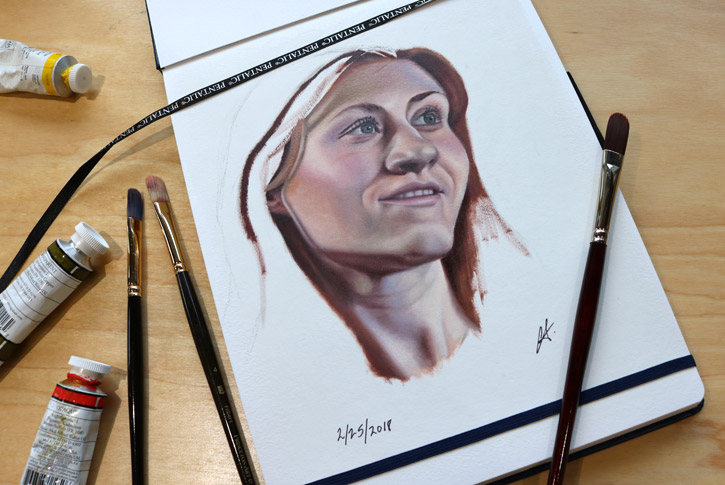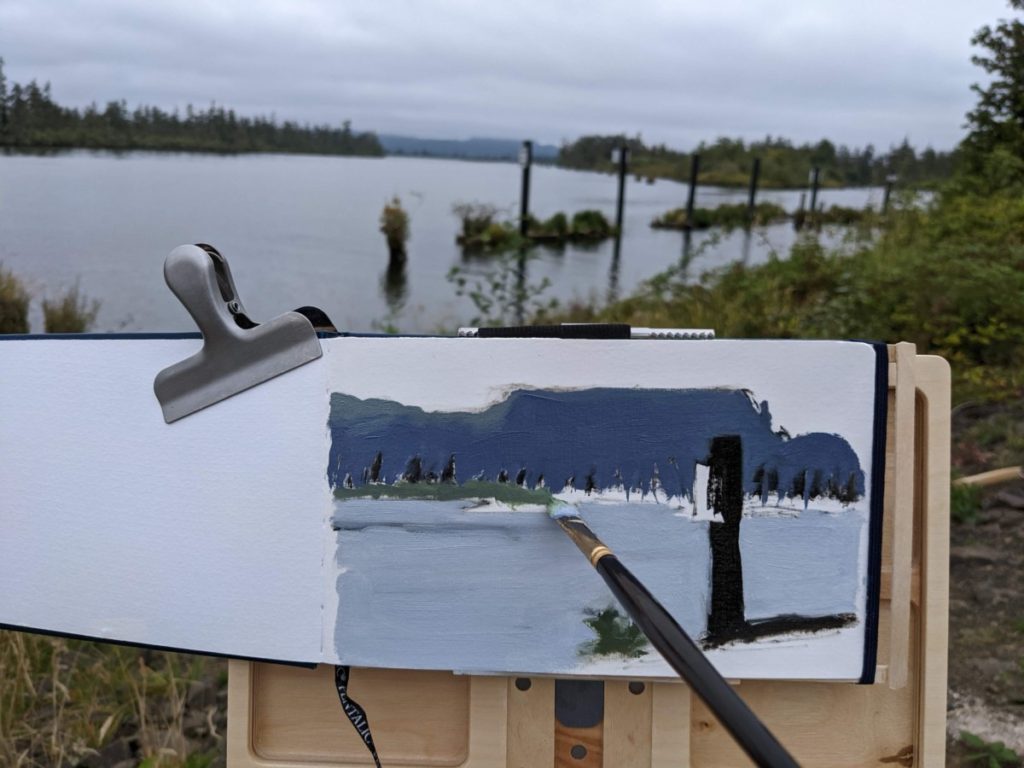
There are many great reasons to oil paint in a sketchbook. For example, sketchbooks are light, relatively inexpensive, and portable.
Oil painting in a sketchbook requires a little preparation and is a great choice for painting on location or doing studies.
Traveling and oil painting can take up a lot of storage space, using a sketchbook for your oil paintings will lighten your load and pack very easily once the painting has dried. Sketchbooks are great for doing studies because if you are new to oil painting and just want to practice, this can be a great option to save money on your painting surfaces. If you happen to paint one you love you can always cut the page out of the sketchbook and frame it. For me, one of the best reasons to paint in a sketchbook is to save space in my studio. I have been painting for over two decades and that means I have dozens of paintings laying around, it really helps to have my painting studies, which I don’t intend to sell, neatly tucked away in a sketchbook.
Here is a step-by-step guide for how to prepare a sketchbook for oil painting. What you need to know about the type of paper and how to prepare it.
1. Choose A Sketchbook
There are many types of sketchbooks out there, what type of paper is the best for an oil painting sketchbook? Paper is a very flexible surface and generally, oil paint is not a flexibly medium when dry. This could cause your painting to crack with time. Using sturdier paper will help support the oil painting.
The best sketchbook for oil painting has watercolor paper in 300 GSM weight. The paper should be made of 100% cotton, or a cotton/ linen mix.
You can choose among many sizes and brands of sketchbooks. As for the paper surface, you can choose between a cold press, which has a bit of texture on the surface of the paper. Or you can use hot press paper which has a very smooth surface. In either case, you will need to seal the paper for oil painting.
My favorite watercolor sketchbook is made by Pentalic. The Aqua Journal comes in multiple sizes, it is pretty sturdy for traveling, and it has cold press watercolor paper inside. I have multiple in the 5″ x 8″ and the 8″ x10″. I also like that it has the elastic band and the pen holder for storing my watercolor pencil in that I use to sketch out my paintings. The cover of the Aqua Journal is made of vinyl making it vegan, I prefer the vinyl over cloth because it slides in an out of my backpack a little easier.

If you’d like to try a hot press paper sketchbook, I have tried this one and it works pretty well. It doesn’t have the pen holder, and the cover is cloth, so keep that in mind if you plan to be pulling it in and out of a snug backpack.

2. Seal The Paper
The issue with using oil paints on paper is the solvents and oils in the paint will degrade the paper over time. The oils from the paint will absorb into the paper and can cause ugly yellow or brown stains around the painting. When this happens, it also reduces the flexibility of the dried oil paint and will cause your painting to crack, and it may even flake off the paper. When the oil absorbs into the paper, it also weakens the paper, and over time it may rot and deteriorate. To avoid this, we need to seal the paper first.
The best way to seal paper for oil painting is to use an acrylic primer, or medium.
To seal the paper, brush on a thick layer of your primer across the entire surface of the paper on the side you intend to paint on. You do not need to seal the backside. The sealant will be a smooth, nonabsorbent, surface. This surface will be slick, and the paint can slide across it more than on a primed and gessoed canvas.
Below is my favorite choice for sealing all of my painting surfaces. There are many other brands out there, but I find this one to be thick enough to seal both wood and paper.

3. Adding A Ground Layer To The Paper (Optional)
Adding a ground layer over the sealant will help the oil paint have something to hold onto and absorb into. Without a ground layer, the paint will slide and it may be more difficult to paint on. Gesso is a ground that often has marble dust, clay, or other absorbent type material in it, mixed with an acrylic medium to help it hold together and stick to the paper. There are numerous brands available.
The best ground for oil painting is an acrylic gesso.
Once the gesso is dry, you can feel that it has a slightly rough texture. This tooth will make your oil paint stay in place as you drag your brush across the surface, and it is a much more pleasant feeling than painting directly onto the sealant.
There are many brands of gesso out there. The most important thing to think about is how much texture you want. I have tried several, and I find that I prefer something with more tooth and less of a smooth acrylic feel. I prefer Liquitex Basics Acrylic Gesso.

4. Ready To Paint!
Now that you have chosen your sketchbook, sealed a page, then gessoed it, you are ready to paint. Don’t forget to keep the sketchbook open after you are done painting to make sure that the paint doesn’t smudge into the page in the front. If you are going to be transporting your sketchbook home after painting on location, there are some unique ways you can find to close the book and keep your painting from smudging on the page in front of it. See my post on how to protect oil paintings in a sketchbook on the way home to learn more.
For a detailed video of this process, you can watch my How to Make an Oil Painting Sketchbook video on YouTube.
